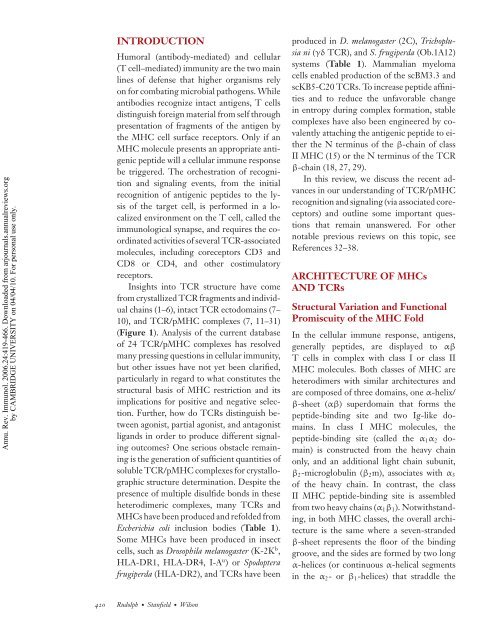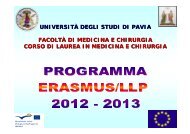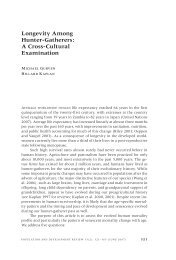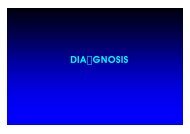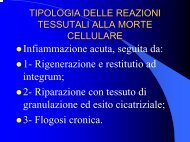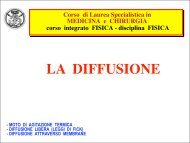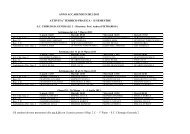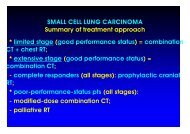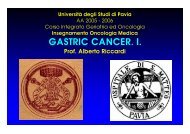Rudolph MG
Rudolph MG
Rudolph MG
You also want an ePaper? Increase the reach of your titles
YUMPU automatically turns print PDFs into web optimized ePapers that Google loves.
Annu. Rev. Immunol. 2006.24:419-466. Downloaded from arjournals.annualreviews.org<br />
by CAMBRIDGE UNIVERSITY on 04/04/10. For personal use only.<br />
INTRODUCTION<br />
Humoral (antibody-mediated) and cellular<br />
(T cell–mediated) immunity are the two main<br />
lines of defense that higher organisms rely<br />
on for combating microbial pathogens. While<br />
antibodies recognize intact antigens, T cells<br />
distinguish foreign material from self through<br />
presentation of fragments of the antigen by<br />
the MHC cell surface receptors. Only if an<br />
MHC molecule presents an appropriate antigenic<br />
peptide will a cellular immune response<br />
be triggered. The orchestration of recognition<br />
and signaling events, from the initial<br />
recognition of antigenic peptides to the lysis<br />
of the target cell, is performed in a localized<br />
environment on the T cell, called the<br />
immunological synapse, and requires the coordinated<br />
activities of several TCR-associated<br />
molecules, including coreceptors CD3 and<br />
CD8 or CD4, and other costimulatory<br />
receptors.<br />
Insights into TCR structure have come<br />
from crystallized TCR fragments and individual<br />
chains (1–6), intact TCR ectodomains (7–<br />
10), and TCR/pMHC complexes (7, 11–31)<br />
(Figure 1). Analysis of the current database<br />
of 24 TCR/pMHC complexes has resolved<br />
many pressing questions in cellular immunity,<br />
but other issues have not yet been clarified,<br />
particularly in regard to what constitutes the<br />
structural basis of MHC restriction and its<br />
implications for positive and negative selection.<br />
Further, how do TCRs distinguish between<br />
agonist, partial agonist, and antagonist<br />
ligands in order to produce different signaling<br />
outcomes? One serious obstacle remaining<br />
is the generation of sufficient quantities of<br />
soluble TCR/pMHC complexes for crystallographic<br />
structure determination. Despite the<br />
presence of multiple disulfide bonds in these<br />
heterodimeric complexes, many TCRs and<br />
MHCs have been produced and refolded from<br />
Escherichia coli inclusion bodies (Table 1).<br />
Some MHCs have been produced in insect<br />
cells, such as Drosophila melanogaster (K-2K b ,<br />
HLA-DR1, HLA-DR4, I-A u )orSpodoptera<br />
frugiperda (HLA-DR2), and TCRs have been<br />
420 <strong>Rudolph</strong>· Stanfield· Wilson<br />
produced in D. melanogaster (2C), Trichoplusia<br />
ni (γδ TCR), and S. frugiperda (Ob.1A12)<br />
systems (Table 1). Mammalian myeloma<br />
cells enabled production of the scBM3.3 and<br />
scKB5-C20 TCRs. To increase peptide affinities<br />
and to reduce the unfavorable change<br />
in entropy during complex formation, stable<br />
complexes have also been engineered by covalently<br />
attaching the antigenic peptide to either<br />
the N terminus of the β-chain of class<br />
II MHC (15) or the N terminus of the TCR<br />
β-chain (18, 27, 29).<br />
In this review, we discuss the recent advances<br />
in our understanding of TCR/pMHC<br />
recognition and signaling (via associated coreceptors)<br />
and outline some important questions<br />
that remain unanswered. For other<br />
notable previous reviews on this topic, see<br />
References 32–38.<br />
ARCHITECTURE OF MHCs<br />
AND TCRs<br />
Structural Variation and Functional<br />
Promiscuity of the MHC Fold<br />
In the cellular immune response, antigens,<br />
generally peptides, are displayed to αβ<br />
T cells in complex with class I or class II<br />
MHC molecules. Both classes of MHC are<br />
heterodimers with similar architectures and<br />
are composed of three domains, one α-helix/<br />
β-sheet (αβ) superdomain that forms the<br />
peptide-binding site and two Ig-like domains.<br />
In class I MHC molecules, the<br />
peptide-binding site (called the α1α2 domain)<br />
is constructed from the heavy chain<br />
only, and an additional light chain subunit,<br />
β2-microglobulin (β2m), associates with α3<br />
of the heavy chain. In contrast, the class<br />
II MHC peptide-binding site is assembled<br />
from two heavy chains (α1β1). Notwithstanding,<br />
in both MHC classes, the overall architecture<br />
is the same where a seven-stranded<br />
β-sheet represents the floor of the binding<br />
groove, and the sides are formed by two long<br />
α-helices (or continuous α-helical segments<br />
in the α2- orβ1-helices) that straddle the


